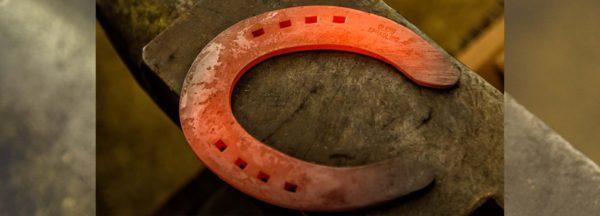Training Tip: Three Ways to Improve the Horse Owner and Farrier Relationship

A skilled farrier is worth his weight in gold, but in a lot of cases, farriers are some of the most underappreciated and underpaid professionals in the horse industry. They are often put in dangerous situations by owners who do not care enough to take the time to properly prepare their horses to have their feet handled.
Aside from making sure your horse is confident about having his feet handled and will stand well for the farrier, here are three tips to maintain a great working partnership with your farrier.
#1: Clean your horse’s hooves and legs.
Pick out your horse’s hooves and make sure his legs are clean for your farrier to work with. This is especially important if your horse is turned out and his pasture is muddy. No one wants to work with a horse whose legs are slick or crusted with mud.
If it’s the time of year when flies are out and about, be sure to put fly spray on your horse so that he stands still and isn’t constantly swishing his tail or stomping his feet. If you expect your farrier to do his best job, make sure you do your part by preparing your horse.
#2: Provide a good working environment.
At the minimum, your farrier will need a well-lit, clean space with an even floor to work on your horse. A covered area that protects him from the beating sun, rain or wind is appreciated.
Don’t set your farrier up in a high-traffic area where other horses and people are constantly walking next to your horse. Even if your horse handles the commotion without a problem, there’s nothing guaranteeing a horse passing by won’t react and kick out or cause a fuss. In the same respect, don’t position your horse in a narrow alleyway or in an area where horses in nearby stalls might try to nip or bite him while the farrier is working.
Give your farrier a safe area to work with your horse so he can focus on his job, not your horse squirming around and potentially injuring him.
#3: Be present and pay attention while your farrier is working.
Don’t expect your farrier to go out to the pasture to catch your horse and bring him up to the barn while you’re nowhere to be found. Be present and stay alert while your farrier is working on your horse, ready to correct your horse if he misbehaves.
When you hold your horse for the farrier, stand on the same side of the horse that the farrier is on. When the farrier is working on your horse’s front and hind left feet, you should be on the left side of the horse, and when he’s working with the right feet, you should be on the right side of the horse. Position yourself in front of the horse off to the side so that you are out of the farrier’s working space. Don’t stand directly in front of the horse’s shoulder, where the farrier will need to stretch the leg forward if they use a stand.
Looking for more training tips? Check out the No Worries Club. Have a training question? Send it to us at [email protected].
